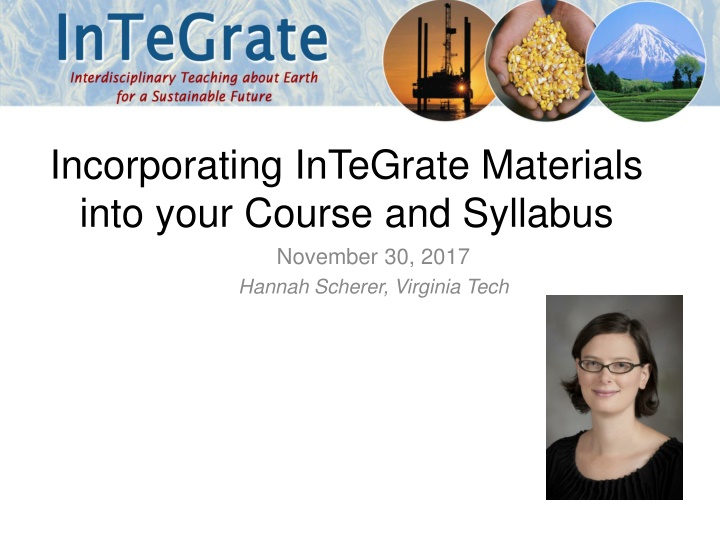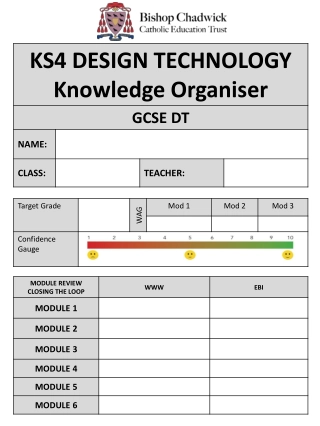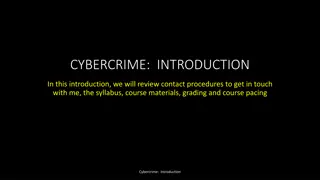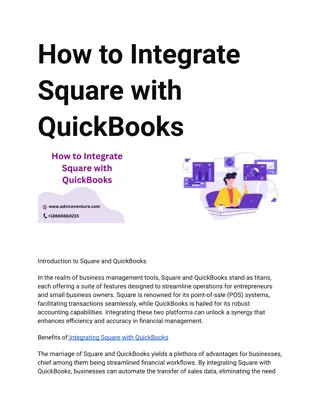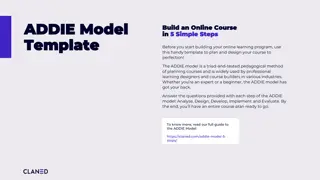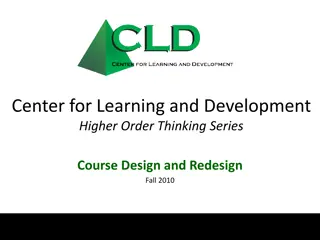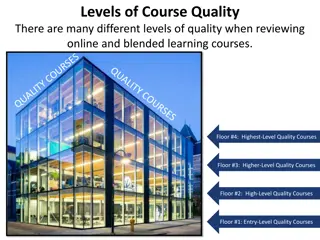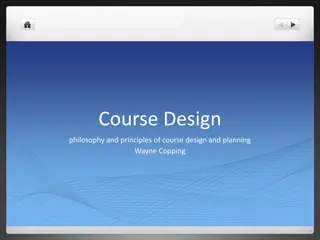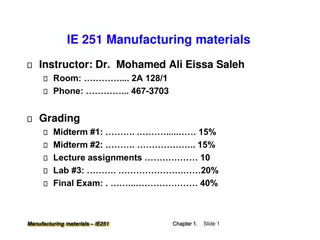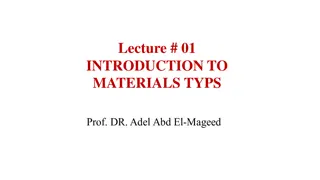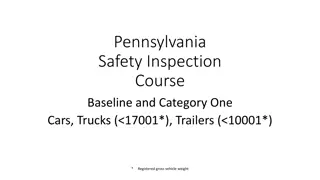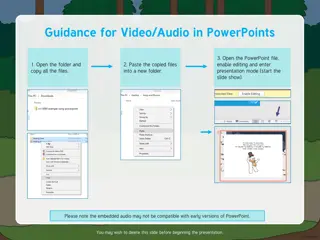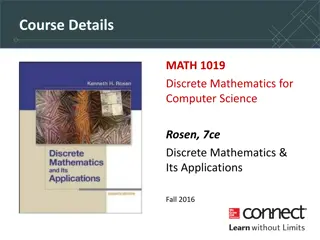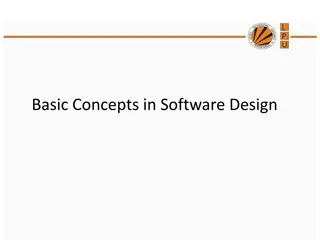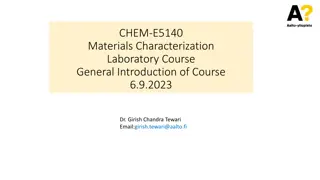Incorporating InTeGrate Materials for Effective Course Design
Process of incorporating InTeGrate modules into your course, emphasizing learner-centered design principles like backward course planning. Discover strategies to enhance student learning outcomes and engagement through authentic geoscience data, interdisciplinary problem-solving, and systems thinking skills. Transform your syllabus from traditional to learner-centered for lasting impact on student learning.
Download Presentation

Please find below an Image/Link to download the presentation.
The content on the website is provided AS IS for your information and personal use only. It may not be sold, licensed, or shared on other websites without obtaining consent from the author.If you encounter any issues during the download, it is possible that the publisher has removed the file from their server.
You are allowed to download the files provided on this website for personal or commercial use, subject to the condition that they are used lawfully. All files are the property of their respective owners.
The content on the website is provided AS IS for your information and personal use only. It may not be sold, licensed, or shared on other websites without obtaining consent from the author.
E N D
Presentation Transcript
Incorporating InTeGrate Materials into your Course and Syllabus November 30, 2017 Hannah Scherer, Virginia Tech
Webinar Goals Facilitate planning for incorporating InTeGrate modules into your course Share resources for further exploration Answer questions!
Guiding principles Address one or more geoscience-related grand challenges facing society Develop student ability to address interdisciplinary problems Improve student understanding of the nature and methods of geoscience and developing geoscientific habits of mind Make use of authentic and credible geoscience data to learn central concepts in the context of geoscience methods of inquiry Develop students ability and propensity to use systems thinking geoscientific thinking skills
If you could choose one thing What would you want students to remember from your course in (5, 10, 20) years? How do we design courses that facilitate this process?
Course Design Traditional = instructor-centered Typical syllabus Week 1: Chapter 1 Week 2: Chapter 2 List Course Topics Design Instruction Design Exams/Papers Typically graded based on 1-2 midterms Final Wiggins and McTighe (1998)
Course Design Backward = learner-centered Identify outcomes: what you want students to know and be able to do Typical syllabus Learning goals Organization of course Figure out how you will know that they know Typically graded based on Weekly assignments Projects Design activities that help them succeed Wiggins and McTighe (1998)
Backward Design 1. Identify desired results learning goals/outcomes Enduring understandings: that one thing Course-level outcomes: aspirational and substantial Unit-level outcomes: achievable and measurable Goals should bundle up 2. Determine acceptable evidence assessment Consider a wide range of assessments Match assessments to learning outcomes 3. Plan learning experiences Use instructional strategies that foster engagement Design activities that give students practice
Backward Design Identify Desired Results Determine Acceptable Evidence Plan Learning Experiences and Instruction Wiggins and McTighe (1998)
Participant poll In the chat box, please indicate if you have already chosen a module to incorporate into your course (yes or no) If yes, which one? If no, where are you in the process?
Resource pages (using InTeGrate) Using InTeGrate modules and courses https://serc.carleton.edu/integrate/teaching_ materials/adapting.html How the Community is Using InTeGrate Materials https://serc.carleton.edu/integrate/teaching_ materials/community_use/index.html
Action Plan Guiding questions to help facilitate your process (overview with examples and resources) https://serc.carleton.edu/integrate/info_team_members/hbcu_testers_team/action_plan. html
Goals/Objectives 1. What are the objectives (content) that you are addressing in your course using the selected InTeGrate module? 2. Have you included those objectives in this course before? If so, how did you teach the material and assess those objectives? If not, why are you including them now?
Goals/Objectives Environmental Justice and Freshwater Resources https://serc.carleton.edu/integrate/teaching_ materials/freshwater/overview.html A Growing Concern https://serc.carleton.edu/integrate/teaching_ materials/sustain_agriculture/assessment.ht ml
Teaching approach 3. Describe the pedagogical techniques you will use to facilitate the InTeGrate activities and reinforce the content. Note that this will require you to spend some time reading through the units in the module to familiarize yourself with the way they are structured and what techniques are utilized.
Teaching approach Environmental Justice and Freshwater Resources: think-pair-share https://serc.carleton.edu/integrate/teaching_ materials/freshwater/unit1.html A Growing Concern: Guided interactive lecture https://serc.carleton.edu/integrate/teaching_ materials/sustain_agriculture/activity5.html
Resource Pages (pedagogy) Interactive Lecture Techniques https://serc.carleton.edu/introgeo/interactive/ typesoftechniqu.html Pedagogy in Action: Teaching Methods https://serc.carleton.edu/sp/library/pedagogi es.html
Adaptations 4. What adaptations, if any, are you making to the InTeGrate materials to fit your course? What adaptations to your course are you making to fit the InTeGrate materials?
Adaptations Map Your Hazards https://serc.carleton.edu/integrate/teaching_ materials/instructor_stories/143702.html A Growing Concern https://serc.carleton.edu/integrate/teaching_ materials/sustain_agriculture/instructor_stori es.htm
Assessments 5. How will you use the module assessments to measure your objectives? Consider both formative and summative assessments that are part of the module and how you will incorporate them into the grading structure for your course.
Assessments Environmental Justice and Freshwater Resources: Formative Assessment https://serc.carleton.edu/integrate/teaching_ materials/freshwater/unit1.html A Growing Concern: Summative assessment https://serc.carleton.edu/integrate/teaching_ materials/sustain_agriculture/activity6.html
Syllabus 6. What modifications do you need to make to your syllabus to communicate expectations for the InTeGrate module activities and assessments to your students?
Syllabus Environmental Justice and Freshwater Resources https://serc.carleton.edu/integrate/teaching_material s/freshwater/villalobos_story.html A Growing Concern https://d32ogoqmya1dw8.cloudfront.net/files/integrat e/teaching_materials/sustain_agriculture/ecological_ agriculture_syllabu.v2.pdf https://d32ogoqmya1dw8.cloudfront.net/files/integrat e/teaching_materials/sustain_agriculture/course_ove rview_activity_track.v3.pdf
Lingering questions and next steps 7. What questions do you still have about how you will implement the InTeGrate materials? 8. What do you need to get done before implementation (e.g. modify handout 3 to include more information on ecosystem services)? This will be your to do list moving forward.
